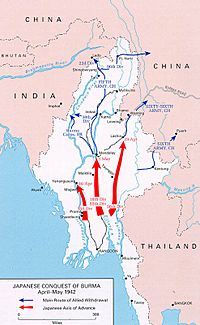Battle of Yenangyaung facts for kids
Quick facts for kids Battle of Yenangyaung |
|||||||
|---|---|---|---|---|---|---|---|
| Part of the Burma Campaign | |||||||
 The Japanese conquest of Burma (the left red arrow represents Japanese movements to Yenangyaung) |
|||||||
|
|||||||
| Belligerents | |||||||
| Commanders and leaders | |||||||
| Units involved | |||||||
|
|
|||||||
| Strength | |||||||
| 10,000 | |||||||
| Casualties and losses | |||||||
| 204 killed 318 wounded 20 missing |
700 killed | ||||||
The Battle of Yenangyaung (which means "Great Victory at Yenangyaung" in Chinese) was an important fight during World War II. It happened in Burma, which is now called Myanmar. This battle was part of the larger Burma Campaign. The fighting took place near the town of Yenangyaung and its valuable oil fields.
Why the Battle Happened
After the Japanese army captured Rangoon in March 1942, the Allied forces had to regroup. The Allies included soldiers from Britain, India, and local Burmese troops. They formed a new group called the Burma Corps, led by Lieutenant General William Slim. Their job was to defend the Irrawaddy River valley. At the same time, the Chinese Expeditionary Force (in Burma) defended the Sittaung River valley to the east.
The Japanese had recently captured Singapore and the Dutch East Indies. This meant they had more soldiers and trucks available. They sent these extra forces to Burma to attack Central Burma. One of their main goals was to take control of the Yenangyaung oil fields.
The fight for the oil fields began on April 10 and lasted for a week. The Japanese attacked the 1st Burma Division and the 48th Indian Infantry Brigade. They were pushed back with many losses. Over the next few days, the British forces slowly retreated as the Japanese kept attacking. At times, Japanese roadblocks split the Allied forces into smaller groups.
By April 15, the situation was very serious. Lieutenant General Slim ordered the oil fields and their equipment to be destroyed. This was to prevent the Japanese from using them. General Harold Alexander, who was in charge of the Burma Army, asked for urgent help. He asked Lieutenant General Joseph Stilwell, an American commander, to send the Chinese 38th Division to the Yenangyaung area right away.
The Battle of Yenangyaung
On April 16, about 7,000 British soldiers, along with 500 prisoners and civilians, were surrounded. They were trapped by a similar number of Japanese soldiers from the Japanese 33rd Division near Yenangyaung and its oil fields.
The Japanese division had moved between two Allied groups, trapping the British. Lieutenant General Slim asked for help from General Sun Li-jen and his Chinese 38th Division. General Sun wanted to lead his whole division to rescue the trapped British soldiers. However, General Lo Cho-ying, the commander of the Chinese Expeditionary Force, said no.
So, on April 17, General Sun led only his 113th Regiment on the rescue mission. This group had only 1,121 men, and only about 800 of them were combat soldiers. The Chinese soldiers did not have their own artillery or tanks. So, Lieutenant General Slim gave them the 7th Armoured Brigade. This brigade was led by Brigadier John Anstice and included two groups of M3 Stuart light tanks and powerful 25-pounder guns.
For the next three days, the Chinese forces attacked southwards. The weather was extremely hot, reaching over 45 degrees Celsius (114 degrees Fahrenheit). A thick cloud of smoke from the destroyed oil wells hung over the battlefield.
Meanwhile, the trapped 1st Burma Division fought its way towards the Pin Chaung river. They met the Chinese relief column on April 19. The next day, the Chinese forces attacked south towards Yenangyaung and Pin Chaung. This attack caused many losses for the Japanese. However, the Allied forces were too tired to hold the oil fields. They had to retreat further north.
What Happened After
For the British, losing the Yenangyaung oil fields was a big problem. They had already lost their main supply port in Rangoon. Now, without a source of fuel, they had to decide where to retreat next. The battle showed the strong cooperation between the Chinese and British forces during a very difficult time.
See also
- Yenangyaung
- Battle of Toungoo
- Chinese Army in India
- New 1st Army
- Du Yuming
- Sun Liren
- National Revolutionary Army

